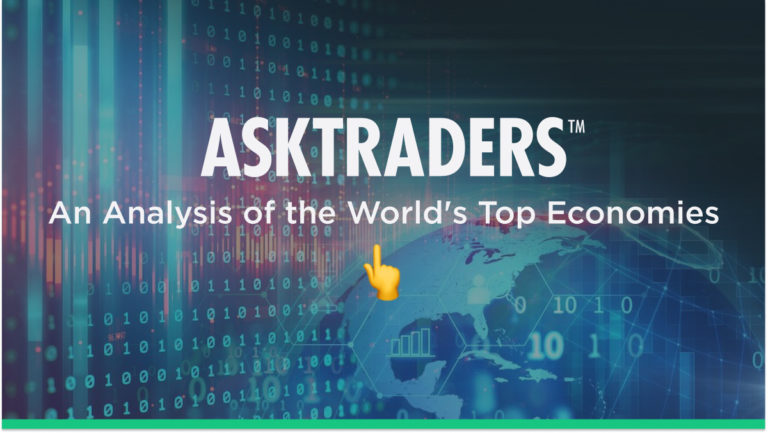
The world economy is becoming increasingly interconnected, and savvy traders need to be aware of the major players on the global stage – knowledge that can be key to successful trading. This article will explore the largest 7 economies in the world and analyse the composition of their economic power.
The following economies will be examined:
- United States
- China
- Japan
- Germany
- United Kingdom
- India
- France
To have a ranking of the ‘largest’ economies in the world, we must first define what we mean by this term. There are multiple ways to define ‘largest’ in terms of economic strength, ranging from Purchasing Power Parity (PPP) to Gross Domestic Product (GDP) and even linked measures, such as Gross National Product (GNP) and Gross National Income (GNI).
For the purposes of this article, we will rank by the commonly used Gross Domestic Product (abbreviated to GDP). This is a monetary measure that condenses all the goods and services produced by an economy or region in a specific time period – most often one year.
As previously stated, Purchasing Power Parity can also be used as a measure of economic size, giving a slightly different perspective. This is because it is similarly a monetary value of goods and services produced by an economy but also removes the differences in price level between countries to equalise the purchasing power of different currencies. We will not be ranking by PPP in this article, but it can be interesting to analyse.
To rank these countries, we will use the most recent World Bank data (May 2020)*
| Position | Country |
GDP in trillion USD |
| 1 | United States | 20.95 |
| 2 | China | 14.72 |
| 3 | Japan | 5.06 |
| 4 | Germany | 3.85 |
| 5 | United Kingdom | 2.76 |
| 6 | India | 2.66 |
| 7 | France | 2.63 |
1. United States
The United States (US) is the world’s largest economy and has been for a long time, dating back to 1890 when it surpassed the United Kingdom. However, its reign appears to be coming to an end with China catching up quickly. The US also ranks second in terms of PPP, only behind the aforementioned China, and seventh in GDP per capita in 2022.
The service sector is the largest contributor to the US GDP, which comprises insurance, real estate, finance and healthcare. The US is seen as the most technologically advanced economy in the world, with many of its firms at the forefront of innovation in areas such as pharmaceuticals, computing, medical, military technology and artificial intelligence.
The US economy is also helped by the country’s abundance of natural resources, evident by it being the largest producer of natural gas and petroleum in the world. This contributes to the US being the second-largest exporter in the world, only falling short of China. Despite this, the US still operates at a trade deficit as the largest importer in the world.
In addition, the US is home to the world’s two largest stock exchanges in terms of trade volume and market capitalisation, being the Nasdaq and New York Stock Exchange.
The US dollar (USD) has a floating exchange rate and is the most commonly used currency in international trades, being by far the world’s largest reserve currency. This is due to the confidence people have in the US economy, which naturally backs the USD – so much so, that some countries use it as their currency and others peg their currency to it.

2. China
China is currently the world’s second-largest economy. However, it is growing significantly faster than the US, with growth rates over three decades averaging over 10% and most forecasts stating it will overtake the US by 2030.
China is a socialist market economy and has become increasingly open over the past 40 years, being the world’s largest exporter, manufacturer of goods and second-largest importer, whilst running a trade surplus.
The country is home to a growing private sector benefiting from foreign investment, but despite this, over 60% of the economy still comprises economic planning by the state, made up of mixed and state-owned enterprises.
The Chinese yuan follows a floating exchange rate but is also managed mainly against the USD with a basket of currencies, being allowed to deviate 0.5% daily. It also has a large bond market, only smaller than the US, along with having the Shanghai, Shenzhen and Hong Kong stock exchanges, which all rank within the top 10 in the world (by trading volume and market capitalisation).
3. Japan
Japan is a developed free market economy, which has become export-orientated and manufacturing-heavy through substantial cooperation between government and advanced technology firms. Evidence of this is Japan’s successful automobile industry with large brand names such as Toyota, Honda, Nissan, Mitsubishi and Suzuki, while also leading the world in multiple patent filing measures.
The Nikkei 225 is Japan’s equivalent to the Dow Jones and is the fifth largest stock exchange in the world by market capitalisation. The Japanese yen is unique as it is seen as an extremely safe currency. The reasons for this are the country’s military neutrality combined with the economy’s long-run budget and trade surplus.
Japan has one of the lowest unemployment rates in the world. However, it faces the problem of a declining and ageing population, along with the highest public debt of any developed country at 266% of GDP. The government must try to combat these in the future.
4. Germany
Next on our list is Europe’s largest economy, Germany, which relies heavily on the export of high-quality goods produced by its highly-skilled workforce. These exports are largely from the service sector, contributing to 70% of GDP, with 29% from industry and less than 1% from agriculture. The result is that Germany runs a significant trade surplus – being the largest in the world in 2016.
Germany was a founding member of the EU and adopted the euro as its currency upon its induction in 1999, which means Germany’s monetary policy is determined by the European Central Bank (ECB) and is not fully under its control.
5. United Kingdom
The fifth-largest economy in the world, the UK economy, has seen its power decline relative to its counterparts over the last century, but still has significant influence across the globe. Its economy is largely driven by its service sector, which includes insurance, business, and most importantly, finance services. The latter accounts for 8.6% of GDP. The vast majority of these finance services are located in London, which is only behind New York as a finance centre and is Europe’s largest city by GDP per capita. However, this contributes to regional variation in income, with higher income towards South East England.
The UK left the EU in 2020, but even previous to this, it chose not to join the monetary union, sticking with pound sterling. This allowed the UK to set its monetary policy via the Bank of England.
The FTSE 100 is one of the most popular indices in the world, containing the 100 companies with the highest market capitalisation listed on the London Stock Exchange. You can learn more about investing in the UK with our ‘Best Short-Term Investments in the UK’ guide.
6. India
In sixth place, we have India. However, it would rank third in terms of PPP rankings – highlighting the lower cost of living. India is still seen as a developing economy and is growing at rapid speed.
India is one of the world’s largest suppliers, providing textiles, cement and natural resources to the world’s economy – also exporting large amounts of crude oil and natural gas. Furthermore, it is a large producer of commodities, with 66% of the population working in agriculture and food production. Despite this, India’s fastest growing sector is clearly the service sector, contributing to around 50% of GDP.
7. France
Seventh on our list is France, with an economy that relies heavily on tourism. Being the most visited tourist destination in the world, France’s tourism sector represents around 10% of its GDP and 11% of domestic employment. This is partially reflected in France’s large service sector, accounting for over 78% of GDP.
Much like Germany, France was a founding member of the eurozone. Adopting the euro in 1999, again this means it cannot control its own monetary policy, but the ECB does.
France is also a significant power in the pharmaceutical, chemical and automobile industries, helped out by the fact it is Europe’s leader in receiving foreign direct investment.
If you have enjoyed reading this article, you may also like our daily news items on the macroeconomic and fundamental events that are impacting global markets today. Navigate to our latest market analysis stories.




